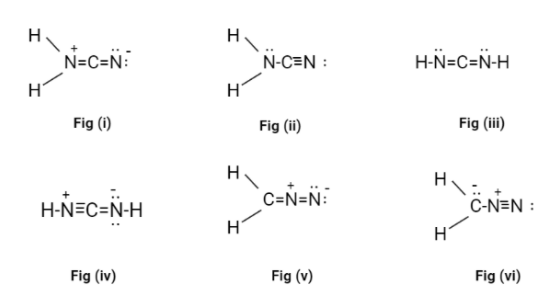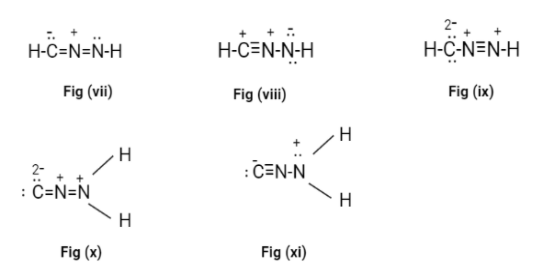
What isomeric Lewis structure of $C{N_2}{H_2}$ has no formally charged atoms?
Answer
513k+ views
Hint :A formal charge (FC) is a charge given to an atom in a molecule based on the assumption that electrons in all chemical bonds are exchanged equally among atoms, regardless of relative electronegativity. When choosing the best Lewis structure for a molecule, it is important to keep the formal charge on each of the atoms as low as possible.
Complete Step By Step Answer:
We know that both $H - N = C = N - H$and ${H_2}N - C \equiv N$has no formally charged atoms. Now, we should draw all possible Lewis structures for the compound to check their connectivity.
For non-hydrogen atoms, all possible structures are $N - C - NandC - N - N$. Now, we will add all the Hydrogen atoms to this structure.
$
{H_2}N - C - N \\
H - N - C - N - H \\
{H_2}C - N - N \\
H - C - N - N - H \\
C - N - N{H_2} \\
$
Hence, there are $5$possible combinations.
Now, we will calculate the number of pi electrons in the molecule using the formula
$P = 6n + 2 - V$
$n$ is the number of non-hydrogen atoms.
$V$is the number of valence electrons.
$
P = 6 \times 3 + 2 - \left( {1 \times 4 + 2 \times 5 + 2 \times 1} \right) \\
P = 18 + 2 - \left( {4 + 10 + 2} \right) \\
P = 18 + 2 - 16 \\
P = 4 \\
$
Hence, there are 4 pi electrons, that means the compound can either have two double bond or one single and one triple bond.
Now, we will draw new structures with all possible combinations of double and triple bonds, with the valance electrons and the formal charge on each atom.


Now, in all the possible Lewis structures only fig(ii) and fig(iii) don’t have a formal charge on it. These structures are called cyanamide.
Note :
Cyanide is a fast-acting, highly lethal compound that can take several different forms. Cyanide can be in the form of a colorless vapor, such as hydrogen cyanide $(HCN)$or cyanogen chloride $(CNCl)$, or in the form of a crystal, such as sodium cyanide $(NaCN)$ or potassium cyanide $(KCN)$.
Complete Step By Step Answer:
We know that both $H - N = C = N - H$and ${H_2}N - C \equiv N$has no formally charged atoms. Now, we should draw all possible Lewis structures for the compound to check their connectivity.
For non-hydrogen atoms, all possible structures are $N - C - NandC - N - N$. Now, we will add all the Hydrogen atoms to this structure.
$
{H_2}N - C - N \\
H - N - C - N - H \\
{H_2}C - N - N \\
H - C - N - N - H \\
C - N - N{H_2} \\
$
Hence, there are $5$possible combinations.
Now, we will calculate the number of pi electrons in the molecule using the formula
$P = 6n + 2 - V$
$n$ is the number of non-hydrogen atoms.
$V$is the number of valence electrons.
$
P = 6 \times 3 + 2 - \left( {1 \times 4 + 2 \times 5 + 2 \times 1} \right) \\
P = 18 + 2 - \left( {4 + 10 + 2} \right) \\
P = 18 + 2 - 16 \\
P = 4 \\
$
Hence, there are 4 pi electrons, that means the compound can either have two double bond or one single and one triple bond.
Now, we will draw new structures with all possible combinations of double and triple bonds, with the valance electrons and the formal charge on each atom.


Now, in all the possible Lewis structures only fig(ii) and fig(iii) don’t have a formal charge on it. These structures are called cyanamide.
Note :
Cyanide is a fast-acting, highly lethal compound that can take several different forms. Cyanide can be in the form of a colorless vapor, such as hydrogen cyanide $(HCN)$or cyanogen chloride $(CNCl)$, or in the form of a crystal, such as sodium cyanide $(NaCN)$ or potassium cyanide $(KCN)$.
Recently Updated Pages
Why are manures considered better than fertilizers class 11 biology CBSE

Find the coordinates of the midpoint of the line segment class 11 maths CBSE

Distinguish between static friction limiting friction class 11 physics CBSE

The Chairman of the constituent Assembly was A Jawaharlal class 11 social science CBSE

The first National Commission on Labour NCL submitted class 11 social science CBSE

Number of all subshell of n + l 7 is A 4 B 5 C 6 D class 11 chemistry CBSE

Trending doubts
Differentiate between an exothermic and an endothermic class 11 chemistry CBSE

10 examples of friction in our daily life

One Metric ton is equal to kg A 10000 B 1000 C 100 class 11 physics CBSE

Difference Between Prokaryotic Cells and Eukaryotic Cells

1 Quintal is equal to a 110 kg b 10 kg c 100kg d 1000 class 11 physics CBSE

State the laws of reflection of light




